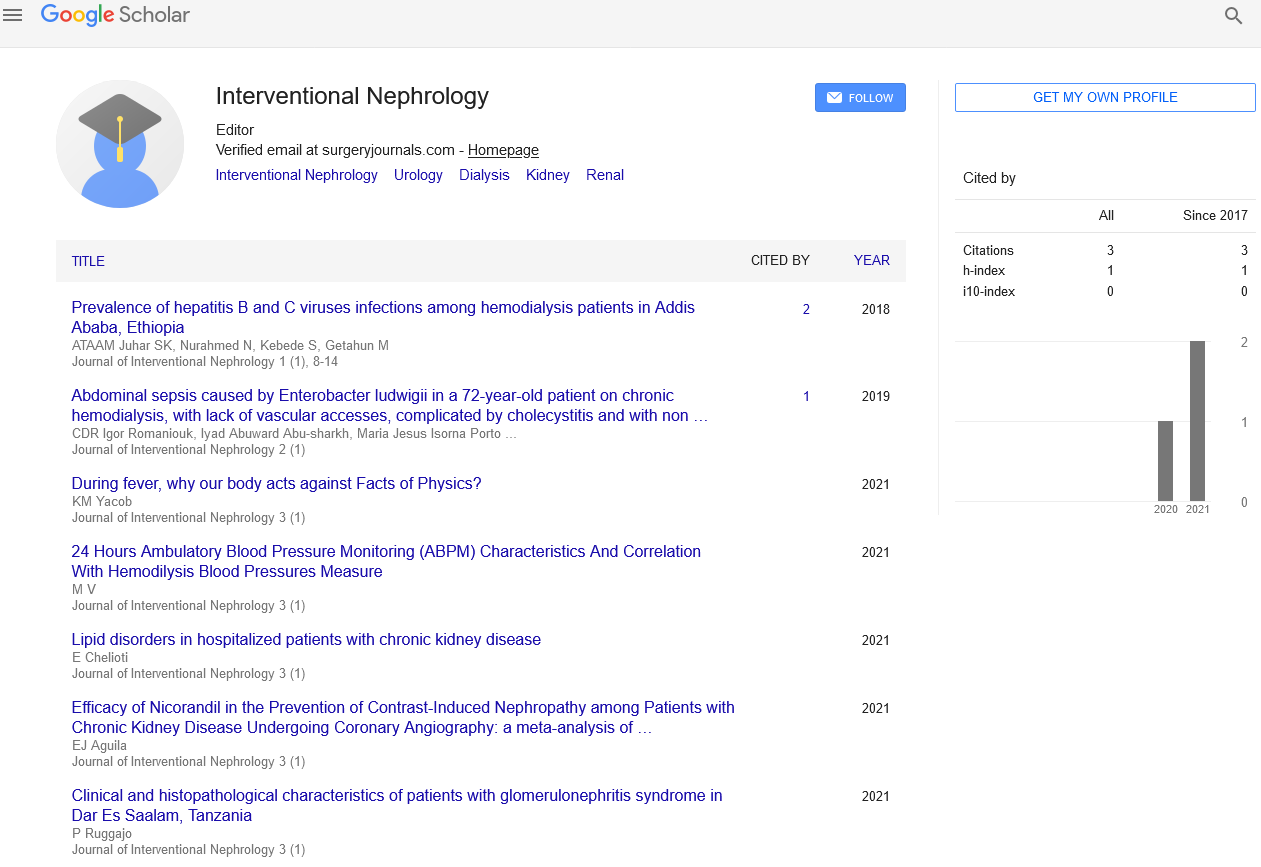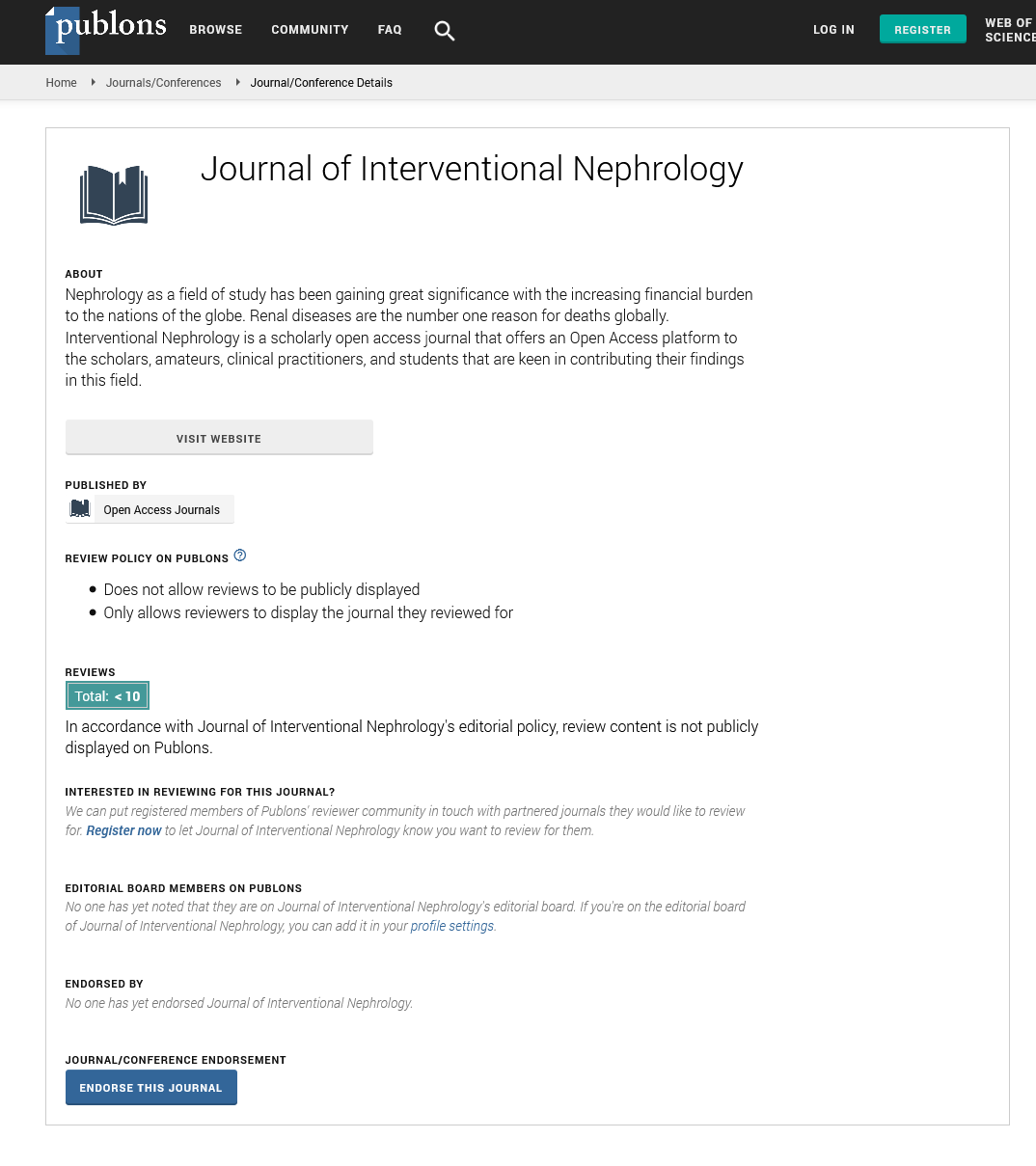Short Communication - Journal of Interventional Nephrology (2018) Volume 1, Issue 1
Early detection of kidney function in diabetic kidney disease: An approach to prevent end stage renal disease
- Corresponding Author:
- Raisa N Kazi
College of Applied Medical Science, Prince Sattam Bin Abdul-Aziz University, Saudi Arabia
E-mail: raisakolhar@yahoo.co.in
Abstract
Chronic progression of diabetic kidney disease brings a gradual decrease in the renal function. Without early recognition and clinical assessments, would eventually leads to end stage renal failure. The major challenges are to detect it in initial stage or its onset thereby improving diabetic kidney disease outcomes. An insight into the renal function and pathophysiology of diabetic kidney disease will provide an evidence for the renal function impairments. Conventional measurement of albuminuria and glomerular filtration rate are widely being used as marker for detection of renal function impairment in diabetic kidney disease. However, these measures are not accurate having some limitations and are associated with certain percentage of kidney damage. Interestingly recent focus is on the potential use of novel biomarkers for early detection of diabetic kidney disease. Plasma and urinary biomarkers reflecting the glomerular and tubular injury, inflammation and fibrosis considered as being suitable for early detection of diabetic kidney disease. Novel biomarker in identifying kidney disease during the course of diabetes can help to delay or prevents the onset of diabetic kidney disease early enough and possibly prevent the progression towards end stage renal failure. This will have a positive impact on the diagnosis of diabetic kidney disease and decreases the incidence of cardiovascular morbidity and mortality. Consequently, reducing the burden on health care sector and brings an improvement in the health outcome of the diabetic kidney disease patient.
Keywords
Diabetic kidney disease, Renal function, Renal failure
Introduction
Diabetes is a chronic illness that requires good glycemic control and strategies to reduce the risk factors [1]. Kidneys are the organs in the body potentially affected in diabetic patients. Globally, diabetes is an epidemic that has led to a rise in diabetic kidney disease [2]. Kidney disorder in diabetes leads to severe challenging issues progressing into different stages of renal failure [2]. This could eventually be a cause for the development of cardiovascular diseases such as heart attack and stroke [3]. Renal functional impairment is an important indication of the diabetic kidney disease, it is important to assess the functional capacity of the kidney in diabetic kidney disease and monitor the disease progress [4]. The major challenges are to detect it in initial stage and its onset thereby improving diabetic kidney disease outcomes [5,6].
Clinical results of previous studies have shown that diabetic kidney disease is chronic and develops over decades. However, certain diabetes patient exhibits a rapid decline in renal function. Without early recognition and laboratory assessment, this could lead to a transition of chronic kidney disease and subsequently to end stage kidney failure in few months [6,7]. Therefore, it becomes challenging to prevent the renal failure. Over the past two decades, various pathways associated in the pathogenesis of diabetic kidney disease involving a multifactorial interaction have widely been studied, [8] precise mechanism underlying this interaction is not clear. However reports have suggested that pathogenesis and progression of diabetic kidney disease is as a result of interactions between metabolic and hemodynamic pathways, which often include glomerular hyperfiltration, progressive albuminuria, declining glomerular filtration rate. Metabolic alterations that bring a change in the renal hemodynamics and promote inflammation and fibrosis in early diabetes include hyperaminoacidemia, a promoter of glomerular hyperfiltration and hyperperfusion, and hyperglycemia. These metabolic changes leads to glomerular hypertrophy, glomerulosclerosis, and tubulointerstitial inflammation and fibrosis [8,9]. Moreover, oxidative stress due to increase production of reactive oxygen species is considered to play an important role in the progression of diabetic kidney disease. Reports have demonstrated a close correlation between urinary oxidative DNA damage biomarker and the severity of microvascular diabetic complications [10,11]. Additionally, the initial change in the glomerular is the thickening of glomerular basement membrane, loss of endothelial fenestrations, mesangial matrix expansion, and loss of podocyte [9,12].
Often, clinical interpretation of diabetic kidney disease is based on the presence of albuminuria and screening of persistent levels of blood urea, serum creatinine, and a decrease in glomerular filtration rate [5,13]. Consequently, evaluation of kidney function based on glomerular filtration rate and albuminuria is now widely been used as marker to access the diabetic kidney disease [6]. Nevertheless decrease in the glomerular filtration rate, increase urinary albumin excretion and presence of tubulo-interstitial atrophy and fibrosis are linked with fewer chronic kidney disease prognosis [9], Also increased serum creatinine concentration is associated with certain percentage of kidney parenchyma damage [14]. These clinical interpretation of diabetic kidney are linked with widespread kidney damage and progression towards end stage renal failure. That could possibly signifies, poor diagnostic approach of kidney function in early stages of chronic kidney disease and hence delayed implementation of therapeutic interventions [15].
In early stages, significant decline of kidney function is an early sign of diabetic kidney. Symptoms of diabetic kidney disease in early stages are usually not significantly obvious. Also, it has been described that decrease in the renal function of a diabetic patient is not always associated with increased albumin level in urine [6,16] if diagnosed early, progression of chronic kidney disease complications can be reduced with therapeutic interventions and good glycemic control [17]. Henceforth present focus is on early detection of compromised kidney function to forecast kidney damage beyond albuminuria and prevention of chronic kidney disease complications. Therefore, the goal is to prevent these initial stages of diabetic kidney disease, not only end stage renal disease.
Modern diagnostic tools includes use of novel biomarkers for detection of diabetic kidney disease progression and early therapeutic intervention to prevent kidney damage prior to reduction in glomerular filtration rate and albuminuria [6,18]. Some of the possible biomarkers as reported by studies in the diagnosis of chronic kidney disease include biomarkers of glomerular and tubular injury, inflammation biomarkers and oxidative biomarkers that precede albuminuria in some patients and thus may be useful for the early detection of diabetic kidney disease. Recent studies have proposed the role of numerous urinary biomarkers that are considered to be more sensitive diagnostic tools for the early detection of diabetic kidney disease and its progression to end-stage kidney disease [15,19]. Studies have reported that tubular biomarkers are primary predictors of diabetic kidney disease, since tubular dysfunction precedes the microalbuminuria and glomerular injury. Urinary tubular biomarkers are elevated before the appearance of microalbuminuria [20]. Urinary microRNAs that regulate gene expression and urine proteomics, highlighting a possible role for epigenetic factors in the development of the disease [21]. Routine use of these biomarkers in future clinical trials would be useful in the diagnosis of different stages of diabetic kidney disease and brings an improvement in the diabetic kidney disease outcome with better therapeutic approach [22]. However practice of these biomarkers in the clinical trial is still underway and proficiency of these biomarkers needs to be evaluated.
Novel therapeutic intervention and techniques are primary focus for the prevention of diabetic kidney disease complications and its progression to end stage renal failure. Since diabetic kidney disease remains one of the leading causes for end stage renal failure. It is presumed that 40% of the diabetic patient develops diabetic kidney disease and a significant population requires renal replacement therapies (dialysis and or transplantation) for end stage renal failure, that makes an important socioeconomic and public health problem [23-25]. Since, a recent study indicates that because of an increase in the prevalence of diabetes and chronic kidney disease, the costs of renal therapy are expected to rise [26,27]. Further it is documented that diabetic kidney disease greatly increases the risk for cardiovascular events. Cardiovascular disease due to diabetic kidney is a primary cause of death in diabetes [28]. Improved diagnostic approach, good glycemic control and arterial blood pressure can lower the risk of developing end stage renal failure and cardiovascular mortality. This would prevent a diabetic person’s need for dialysis [29]. Progressive rise of diabetic kidney disease population globally and the need for dialysis has increased the burden on health care sector. The cost of dialysis or transplantation is frequently unaffordable to many in the absence of governmental aid [30].
Conclusion
Diabetic kidney disease remains a prominent chronic complication of diabetes. Determining the prevalence of diabetic kidney disease and to emphasize the need for timely detection through the use of novel biomarkers will meaningfully improve life among otherwise asymptomatic patients. Additionally, understanding the degree of renal function impairment early enough in diabetes can help slow down the kidney disease progression and transition to end-stage kidney disease. This would bring a reduction in cardiovascular related death in diabetic kidney disease patient.
Authors’ Statement
The present manuscript has not been published previously, that is not under consideration for publication elsewhere, that this publication is approved by all authors who has contributed significantly and that, if accepted, it will not be published elsewhere in the same form, in English or in any other language, without the written consent of the publisher.
Conflict of Interest Statement
We have no financial, consultant, institutional and other relationships that might lead to bias or a conflict of interest.
References
- American Diabetes Association. Glycemic targets: Standards of medical care in diabetes-2018. Diabetes. Care. 41 (Supplement 1), S55-S64 (2018).
- Molitch ME, Adler AI, Flyvbjerg A, et al. Diabetic kidney disease: A clinical update from Kidney Disease: Improving Global Outcomes. Kidney. Int. 87(1), 20-30 (2015).
- Toyoda K, Ninomiya T. Stroke and cerebrovascular diseases in patients with chronic kidney disease. Lancet. Neurol. 13(8), 823-833 (2014).
- Dhondup T, Qian Q. Electrolyte and acid-base disorders in chronic kidney disease and end-stage kidney failure. Blood. Purif. 43(1-3), 179-188 (2017).
- Persson F, Rossing P. Diagnosis of diabetic kidney disease: State of the art and future perspective. Kidney. International. Supplements. 8(1), 2-7 (2018).
- Kim SS, Kim JH, Kim IJ. Current challenges in diabetic nephropathy: Early diagnosis and ways to improve outcomes. Endocrinol. Metab. 31(2), 245-253 (2016).
- Wouters OJ, O'donoghue DJ, Ritchie J, et al. Early chronic kidney disease: Diagnosis, management and models of care. Nat. Rev. Nephrol. 11(8), 491-502 (2015).
- Toth-Manikowski S, Atta MG. Diabetic kidney disease: Pathophysiology and Therapeutic Targets. J. Diabetes. Res. 1-16 (2015).
- Alicic RZ, Rooney MT, Tuttle KR. Diabetic kidney disease challenges, progress, and possibilities. Clin. J. Am. Soc. Nephrol. 12(12), 2032-2045 (2017).
- MacIsaac RJ, Ekinci EI, Jerums G. Markers of and risk factors for the development and progression of diabetic kidney disease. Am. J. Kidney. Dis. 63(2), S39-S62 (2014).
- Hinokio Y, Suzuki S, Hirai M, et al. Oxidative DNA damage in diabetes mellitus: its association with diabetic complications. Diabetologia. 42(8), 995-998 (1999).
- Tuttle KR, Bakris GL, Bilous RW, et al. Diabetic kidney disease: A report from an ADA Consensus Conference. Am. J. Kidney. Dis. 64(4), 510-533 (2014).
- Gaitonde DY, Cook DL, Rivera IM. Chronic kidney disease: Detection and evaluation. Am. Fam. Physician. 96(12), 776-783 (2017).
- Basturk T, Koc Y, Ucar Z, et al. Renal damage frequency in patients with solitary kidney and factors that affect progression. Int. J. Nephrol. 2015, 1-7 (2015).
- Rysz J, Gluba-Brzózka A, Franczyk B, et al. Novel biomarkers in the diagnosis of chronic kidney disease and the prediction of its outcome. Int. J. Mol. Sci. 18(8), 1702 (2017).
- Kamijo-Ikemori A, Sugaya T, Kimura K. Novel urinary biomarkers in early diabetic kidney disease. Curr. Diab. Rep. 14(8), 513 (2014).
- Fink HA, Ishani A, Taylor BC, et al. Chronic kidney disease stages 1-3: screening, monitoring, and treatment (2012).
- Fiseha T. Urinary biomarkers for early diabetic nephropathy in type 2 diabetic patients. Biomark. Res. 3(1), 16 (2015).
- Lee SY, Choi ME. Urinary biomarkers for early diabetic nephropathy: Beyond albuminuria. Pediatr. Nephrol. 30(7), 1063-1075 (2014).
- Khurana R, Ranches G, Schafferer S, et al. Identification of urinary exosomal noncoding RNAs as novel biomarkers in chronic kidney disease. RNA. 23(2), 142-152 (2016).
- Wasung ME, Chawla LS, Madero M. Biomarkers of renal function, which and when? Clinica. Chimica. Acta. 438, 350-357 (2015).
- Uwaezuoke SN. The role of novel biomarkers in predicting diabetic nephropathy: a review. Int. J. Nephrol. Renovasc. Dis. 10, 221-231 (2017).
- Andersen AR, Christiansen JS, Andersen JK, et al. Diabetic nephropathy in type 1 (insulin-dependent) diabetes: an epidemiological study. Diabetologia. 25(6), 496-501 (1983).
- Gheith O, Farouk N, Nampoory N, et al. Diabetic kidney disease: Worldwide difference of prevalence and risk factors. J. Nephropharmacol. 5(1), 49-56 (2016).
- American Diabetes Association. Standards of medical care in diabetes-2014. Diabetes. Care. 37(Supplement 1), S14-S80 (2013).
- Rowley WR, Bezold C, Arikan Y, et al. Diabetes 2030: insights from yesterday, today, and future trends. Popul. Health. Manag. 20(1), 6-12 (2017).
- Mushi L, Marschall P, Fleßa S. The cost of dialysis in low and middle-income countries: A systematic review. BMC. Health. Serv. Res. 15(1), 506 (2015).
- De Boer IH, Bakris GL. Diabetic kidney disease: A determinant of cardiovascular risk in type 1 diabetes. Diabetes. Care. 41(4), 662-663 (2018).
- Bakris GL, Molitch M. Are all patients with type 1 diabetes destined for dialysis if they live long enough? probably not. Diabetes. Care. 41(3), 389-390 (2018).
- Levey AS, Eckardt KU, Tsukamoto Y, et al. Definition and classification of chronic kidney disease: A position statement from Kidney Disease: Improving Global Outcomes (KDIGO). Kidney. Int. 67(6), 2089-2100 (2005).


